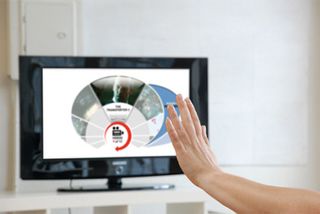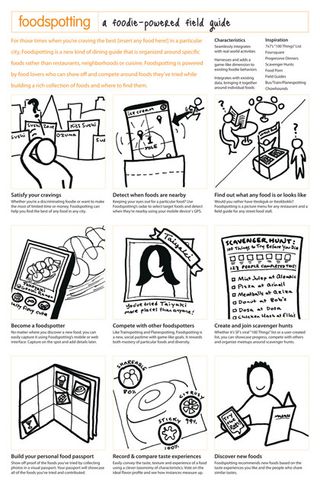The web designer's guide to user experience
Experts demystify the process behind UX design

User experience ('UX' to its friends) is a term increasingly bandied about.
Currently in that strange position of being excitingly new to many, touted as an essential component of web design process by industry experts and seemingly on the way to becoming ubiquitous, UX also has an air of mystery about it.
This is partly because it's tricky to pin down exactly what it is. When interviewed, industry pros told us the term can be "subjective", "hard to describe" and has come to mean various things.
Dan Saffer, principal at Kicker Studios, was perhaps the most succinct, describing UX as "What a customer perceives while engaged with your product and a way of looking at a product holistically, from the point of view of a user who likely doesn't care about how something is made, just the product itself."

HAND CODED: Kicker Studios' Dan Saffer thinks gestural interfaces (as seen in Canesta Gestural Entertainment Centre) will lead to a UX revolution
The benefits of UX design
When people talk about UX design for the web, they're referring to everything that fashions user experience: interface design, information architecture, usability and product design that encompasses the presentation, interaction and organisation of online services.
Get daily insight, inspiration and deals in your inbox
Get the hottest deals available in your inbox plus news, reviews, opinion, analysis and more from the TechRadar team.
"The process for UX design is therefore about understanding and designing a user's experience from start to finish, not just what a website looks like or how it functions," explains Clearleft's user experience director, Andy Budd.
Once, this line of thinking might have seemed overblown in nature, but as Luke Wroblewski, senior principal of product ideation and design at Yahoo, says:
"Barriers to entry in digital products are very low. There are now so many websites that functionality and technology are baseline features and users differentiate on the basis of how something works – the experience they have with it. When competing services are a click away, managing that experience and giving people something they really want to use goes a long way to getting people interested in your output."
Planning good UX
Good UX doesn't happen by magic: you have to plan for it. "Creating a user experience is a given, but creating a good user experience is hard," says Sjors Timmer, user experience designer at Webjam.
"Human decisions can be irrational, so there's no definitive checklist that we use to conclude whether we trust a site or if it's friendly."
Extending this line of thinking, there's no checklist regarding UX design itself – no set process or series of steps to follow. Instead, you master a toolkit of techniques and learn how and when best to use them. However, Paul Seys, Redweb's head of user experience, thinks it best to start with the client, educating them about the importance of a user-centred approach:
"Clients are keen to see something tangible immediately, but we first need to understand the requirements of the business and the needs of users." If a client needs a nudge in the right direction, Dan Saffer suggests reminding them:
"Customers' thoughts about products are mostly influenced by what they experience and feel while using them. A good user experience creates passionate, happier customers, and you can charge more for products and services that people love and that they consider higher in value. A poor user experience is one that no one consciously cares about and, at best, will lead to loss of revenue."
Approaching UX design
Luke Wroblewski says the UX design process examines various factors. Is the product findable? When you get it, do you understand what it is and then how to use it? And if it works, is it desirable? The specific tools used, suggests Budd, depend on the problem at hand:
"If you don't understand a user's needs or goals, a persona or mental model could be useful. If you don't know how to structure a large amount of content, then use process flows or site maps. If you're designing processes such as checkouts, it's hard to visualise them, so sketch wireframes to enable you to examine how users move from one phase to another."
In terms of structuring the process, rather than dealing with specific problems, freelance user experience consultant Leisa Reichelt of Disambiguity thinks UX design operates at two levels:
"At a strategic level, it's identifying and understanding the audience and finding ways to communicate value with them effectively. At a tactical level, it involves looking more at interaction design and usability problems."
She divides work into two broad categories: generative and evaluative. Generative work is about creation, working with organisations to help design, structure and communicate their offering.
"We do this through research, trying to define and understand the end-user audience, focusing on behavioural traits rather than marketing criteria," she explains. "This can then be structured into audience modelling tools, such as personas, which can be powerful in guiding good UX design."
Reichelt starts with pencil and paper for prototypes, and aims to share the direction she's heading in with clients as soon as possible so they understand the strategy that underpins the UX design. If an organisation isn't on board with this, it's hard to get to a great end product and maintain good UX.
"Understanding who your end users are is essential. When you know what tasks they're looking to perform and their mental models on approaching the site, you can structure and label content to support these things, rather than imposing advanced understanding of content on users who lack the knowledge people within the client's organisation have."
Alexa Andrzejewski, interaction designer for Adaptive Path, suggests thinking of yourself as a storyteller:
"Think about the story you want to tell at each point in the design process. Early on, convey the experience of using a product or service without getting into design details – in first person, answer 'I love this product because ...' or 'this product is like ...' On understanding this, tell the story of how flows, screen design and visuals support the experience. Think about the feedback you want at each stage."

VISUAL AID: Interaction designer Alexa Andrzejewski thinks concept posters "are a powerful way to articulate what the experience of using something should feel like"
Most Popular


